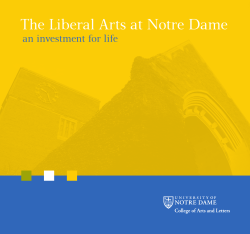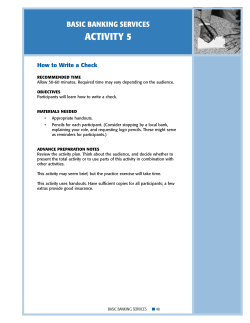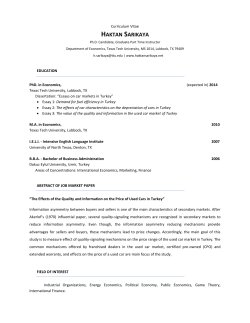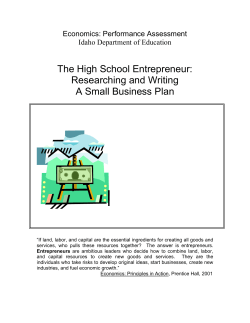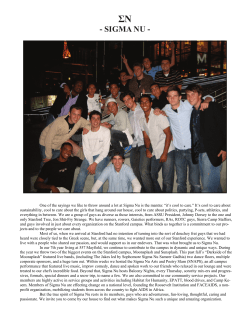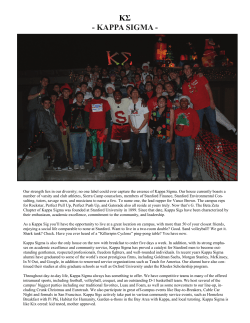
2012 38 Annual Conference of the Eastern Community College Social Science
2012 38th Annual Conference of the Eastern Community College Social Science Association (ECCSSA) Center for Innovative Technology, 2214 Rock Hill Road, Herndon, VA “The Great Renewal: Rebuilding Our Nation—Visions and Challenges.” March 30, 2012 Presenters: Dipak K. (Dee) Roy and Ian Taylor 1.Theory: both “representative agent” (RA) – based and DSGE models ignore adaptive interactions of a variety of actors in networks that lead to crisis. Big weakness. Treats colds, not serious illnesses (Stiglitz) 2. Policy: complex systems science may provide essential insight about economic outcomes-better guidance and tools for regulation (e.g., mapping of financial networks). Why is Economics not an Evolutionary Science? Thorstein Veblen, The Quarterly Journal of Economics, vol. 12, 1898 On the individual in economic theory: “He is an isolated definitive human datum, in stable equilibrium except for the buffets of the impinging forces that displace him in one direction or another.” On the reality: “The economic life history of the individual is a cumulative process of adaptation of means to ends that cumulatively change as the process goes on…” Classical economics is a “taxonomic” discipline, not an evolutionary one. Assumption of “constrained optimization by representative agents” ignores the adaptive and historical nature of economic relationships, processes, and their consequences (Foster 2004). Standard macro models do not consider the networked aspects of lending and global banking. (Gallegati, Stiglitz, 2011). “Economic theory based on the RA model has, in short, nothing to say about financial crises, bankruptcies, domino’s (sic) effects, systemic risk and any pathology in general.” Heterogeneous Interacting Agent Models for Understanding Monetary Economies Joseph E. Stiglitz and Mauro Gallegati, Eastern Economic Journal, 2011, 37, (6–12) “ The era of globalization is the era of connectedness. This reality represents an increasingly troubling challenge to traditional theories and models of social systems, which assume the independence of individuals from their broader social milieu.” http://www.iq.harvard.edu/blog/netgov/ “In physics you are playing against God, and he doesn’t change his laws very often. In finance you are playing against God’s creatures”. --Emanuel Derman, engineering professor, Columbia Univ. Models Behaving Badly Why Confusing Illusion with Reality Can Lead to Disaster on Wall Street and in Life, Free Press, 2011 Why is Economics not a Complex Systems Science? John Foster Discussion Paper No.336, December 2004, School of Economics, The University of Queensland. http://www2.econ.iastate.edu/tesfatsi/macrocas.foster.pdf " published: 2010 Jackson is prof. of economics at Stanford U. "Lucid and comprehensive, Jackson's book elegantly synthesizes several important strands of network science from sociology, physics, mathematics, computer science, and economics. It will be an immensely useful reference for researchers and students alike."--Duncan Watts, Columbia University Systemic Risk Tipping Point Contagion Derivatives Firewall Too Big to Fail Too Interconnected to Fail Complex Systems Science: network theory and related fields: The end of narrow disciplines: an academic revolution…. (source: Kimmo Soramaki, 2011) Financial Network Analysis Social Network Analysis Network Science NETWORK THEORY Graph & Matrix Theory Computer Science Biological Network Analysis Recent financial crisis brought to light the need to look at links between financial institutions Networks are a natural way to visualize the financial system ‘Network thinking’ widespread by regulators Mapping of the financial system has only begun Eratosthenes' map of the known world, c.194 BC. “Too big to fail” + “Too interconnected to fail” Source: Keble College, Oxford U http://www.keble.ox.ac.uk/academics/advanced-studiescentre-1/networks “…interdependencies across different systems and markets are potentially more important for financial stability than interdependencies within the system. This is the case because these types of links have the potential to dramatically change the behaviour of market participants.” --European Central Bank (ECB) “Recent advances in modelling systemic risk using network analysis” January 2010 (p. 25). “Within a certain range, connections serve as a shock-absorber. The system acts as a mutual insurance device with disturbances dispersed and dissipated. Connectivity engenders robustness. Risk-sharing – diversification – prevails. But beyond a certain range, the system can flip the wrong side of the knifeedge. Interconnections serve as shockamplifiers, not dampeners, as losses cascade”. His 2009 speech may be a real watershed, widely cited since then… PBS Frontline TV show, “The Warning”, October 2009 --The inability of Brooksley Born (head of CFTC) to regulate derivatives during the Clinton years. Shut down by Alan Greenspan and Robert Rubin through Congress.. --Clinton also deregulated the banking system by repealing the Glass-Steagall Act in 1999. (had separated commercial from investment banking). Disaster…. http://www.pbs.org/wgbh/pages/frontline/shows/wallstreet/weill/de mise.html “Global financial markets act as complex, scale free, evolving networks that possess key characteristics requiring network management if they are to function with stability” FinancialCrisis and Global Governance:A Network Analysis AndrewSheng, 2010 Working Paper no. 67, Commission on Growth and Devevopment http://www.growthcommission.org/storage/cgdev/documents/gc wp067web.pdf 1. Financial networks now spread contagion much like a disease epidemic (Stiglitz 2010). 2. Public health: epidemics are stopped through quarantine. 3. In finance similar policy needed: capital controls (circuit breakers). Stiglitz: loss of economic welfare much less from regulation and controls than from weathering a global financial crisis… Columbia U. professor, Nobel laureate 2001, econ. Author: “Globalization and its Discontents” Former Chmn. CEA, World Bank chief economist. --IRGC – Emerging risks, Helbing, Oct 2010 "Rethinking Macroeconomics: What Failed and How to Repair It", Journal of the European Economic Association, 9(4), pp.591645., 2010 Risk and Global Economic Architecture: Why Full Financial Integration May Be Undesirable Speech, Aug 15, 2010, Atlanta, Ga http://www2.gsb.columbia.edu/faculty/jstiglitz/download/pape rs/2010_Risk_Global_Architecture.pdf “With fluctuations in the supply of credit being at the center of many economic fluctuations, a theory that has little to say about credit and its determinants is obviously of limited use.” --standard models assume shocks are exogenous. Stiglitz indicates that they are now often man-made: endogenous: “the subprime mortgage crisis was man-made”. (p. 596, Rethinking Macroeconomics) “…Standard Models focusing on money, not credit, where banks and security markets were not well analyzed, provided little guidance on how government could restore the flow of credit. That—not interest rates—was the central issue” (p.609) RETHINKING MACROECONOMICS: WHAT FAILED, AND HOW TO REPAIR IT, Joseph Stiglitz, Journal of the European Economic Association August 2011 “Macro models agree that optimal monetary policy is to keep interest rates low to avoid sectoral misallocation”. Stiglitz argues otherwise, puts him ironically on the same page as the Austrian economists, icons of the Tea Partyists and Rep. Ron Paul ! That’s a revolution ! “While the economic system sometimes amplifies shocks, standard theory argues that economic systems do just the opposite, through several mechanisms”. “Understanding amplification—how small disturbances can give rise to large effects—should be one of the key objectives of macroeconomic research.” “…economic systems (viewed as complex adaptive processes) may exhibit major phase transitions”. This is where the revolution in macroeconomics is coming. “Dodd-Frank and the Myth of “Interconnectedness” by Peter J. Wallison, American Enterprise Institute Wall Street Journal, Friday, Feb. 10, 2012 “There’s no evidence that exposure to Lehman imperiled other banks. So why base a law on that premise?” (Ignores AIG/derivatives-DKR). Real separation of investment banking from commercial banking (return to simple Glass-Steagall type laws; strong Volcker rules: no proprietary trading by banks). Breaking up the banks (seen as crucial by Simon Johnson, MIT prof., former chief economist of the IMF). Reduce the size of financial derivative transactions and contracts outstanding? There were proposals to tax them in the E.U. (OTC notional value is $708 trillion as of 6/11). Limiting international financial network connectivity, capital movements temporarily: “circuit breakers”, like in the stock market (NYSE) currently. (Helbing, Stiglitz). The euro: Robert Mundell’s theory calls for factor mobility in optimal currency areas …..That includes capital mobility Yet, capital mobility may be a transmitting factor in financial networks that have by now reached a tipping point…. Mundell considers fixed exchange rates a stabilizing factor for global financial markets. Obsolete view? ROBERT MUNDELL NOBEL PRIZE 1999 Professor Robert Mundell, 1999 Nobel Laureate: the father of the Theory of Optimum Currency Areas. A Theory of Optimal Currency Areas (1958-1961): “father of the euro” (proposed “europa” in 1969). For the Mundell-Fleming model which integrated the domestic and international sides of an economy (19581961): new policy guide. Should central banks adopt a more discretionary monetary (and regulatory) policy to head off speculative bubbles? They now operate mainly with inflation targeting rules; Ben Bernanke wants to make such a rule official at the Federal Reserve (it’s now informal): this is opposite of discretion. Emphatic yes: we already find game theory in our introductory textbooks. Important to put the 2008 and eurozone financial crises in perspective. We live in a globalized society and economy. Make students aware of the emerging complex systems perspectives and tools being developed. Tipping points, systemic risks… these are central concepts now. Will be in textbooks. So we should be aware of these trends too ! Harvard University Northwestern University (NetLogo) University of Chicago (Booth School) NYU MIT Columbia U. (in sociology, economics) Cornell (mathematics, small world networks) The Santa Fe Institute U.S. Military Academy Also, the New York Fed. There are others, this is a rapidly growing list. 1. Globalization means interconnectedness. 2. Interconnectedness is changing economic and social relations in profound ways, not well understood, but easy to observe. 3. Dynamic and diverse agent interactions, interconnected networks and their interactions with their environment can now result in tipping points that amplify shocks, which then cascade throughout the system. Roles of credit and bankruptcy crucial. 4. Such spreading of systemic risks require an immediate and massive fiscal and monetary policy response. Free market advocates greatly underestimate these effects. 5. But the economy is less responsive in terms of growth and unemployment than before. Okun's Law has become unstable. (In 2008 and 2009 unemployment rose faster and higher than Okun's Law would indicate, but recently unemployment is falling faster than the rate real GDP growth would normally be associated with). 6. Aggressive macro policies may not be sustainable; they may create instability in the global monetary and financial architecture. What should they be if changes in employment are no longer as clearly linked to changes in output? 7. Systemic risks continue to be large; proposed and likely regulatory regimes are nowhere near as significant as during the Great Depression. Derivatives continue to hang over global finance and banking is becoming even more concentrated around the world. 8. Macro models need to be overhauled to make them more useful as diagnostic tools and to point to directions for policy. The interaction of heterogeneous agents and credit, not money and interest rates, need to play a more central role. Economists need to understand banking and finance. Mapping of financial networks might help policymakers better understand the risk and sources of shocks. 9. Policy needs to be directed both toward the "too big to fail" and the "too interconnected to fail" problems. 10. Such policies may create deadweight losses, but such losses are much less than those from a phase transition and resulting global financial crisis with huge losses of wealth as seen in 2008/9 (Stiglitz). 11. Politics will stymie real reform until the next crisis, in which case the risks of continued reliance on outmoded economic ideologies and models, then aggressive monetary and fiscal measures in response to crisis will become even more clear. --the new science of networks (“macro” or system-wide perspective). --dynamic agent-based systems (“micro” or adaptive interaction of agents with environment perspective). Veblen, Thorstein, Why Economics is Not an Evolutionary Science, Quarterly Journal of Economics, Vol. 11, 1898 Why is Economics not a Complex Systems Science? John Foster, Discussion Paper No.336, December 2004, School of Economics, The University of Queensland. From Graph Theory to Models of Economic Networks. A Tutorial, Michael D. Konig and Stefano Battiston, 2009. The Financial Crisis and the Systemic Failure of Academic Economics (Dahlem Report), David Colander, Hans Föllmer, Armin Haas, Michael Goldberg, Katarina Juselius, Alan Kirman,Thomas Lux, and Brigitte Sloth, Kiel Working Paper No. 1489 | February 2009 “Is Network Theory the Best Hope for Regulating Systemic Risk?”, Kimmo Soramaki, European Central Bank Workshop on “recent advances in modelling systemic risk using network analysis”, 5 October, 2009 Financial Crisis and Global Governance: A Network Analysis Andrew Sheng, 2010, World Bank Mapping Systemic Risk in the International Banking Network, Garratt, Mahadeva, Svirydzenka, Working Paper no. 413, Bank of England, Jan 2011. Scale Free Networks, Albert-Laszlo Barabasi, Eric Bonabea, Scientific American, May 2003 On Systemic Risk, Ian Goldin, Oxford U., SeedMagazine.com, Dec. 16, 2010 http://seedmagazine.com/content/article/on_systemic_risk/ Catastrophic cascade of failures in interdependent networks Sergey V. Buldyrev, Roni Parshani, Gerald Paul, H. Eugene Stanley & Shlomo Havlin, Nature,Vol 464| 15 April 2010| doi:10.1038/nature08932 "Rethinking Macroeconomics: What Failed and How to Repair It", Joseph Stiglitz, Journal of the European Economic Association, 9(4), pp.591-645., 2010 "Heterogeneous Interacting Agent Models for Understanding Monetary Economies," Stiglitz, Joseph, with Mauro Gallegati, Eastern Economic Journal, 37 (Winter 2011), 6-12. From Dictatorship to Democracy 2.0 http://www.isn.ethz.ch/isn/Current-Affairs/SpecialFeature/Detail?lng=en&id=137747&contextid774=137747&contextid775=1377 46&tabid=137746 The role of social media in spreading Gene Sharp’s 1993 handbook on nonviolent resistance to authoritarian regimes in the Middle East and elsewhere. Did social media networking create a tipping point throughout the region? 'Arab Spring' Revolutions Follow Game Plan from 1993 Book http://www.youtube.com/watch?v=v5xe5KYbPTk https://gephi.org/2011/the-egyptianrevolution-on-twitter/ Dynamic evolution of a network: clustering. The bright side: networks and their interconnections drive information transmission, communication, technology, social trends, prosperity, new development models for poor countries, productivity and popular democratic movements. The dark side: transmit systemic economic risks and crisis, hacking, theft of intellectual property, globalization of terror, erosion of privacy and enable deeply intrusive tools of political repression. On Systemic Risk by Ian Goldin, Oxford U. SeedMagazine.com, Dec. 16, 2010 http://seedmagazine.com/content/article/on_s ystemic_risk/ Catastrophic cascade of failures in interdependent networks Sergey V. Buldyrev, Roni Parshani, Gerald Paul, H. Eugene Stanley & Shlomo Havlin Vol 464| 15 April 2010| doi:10.1038/nature08932 Nature, April 2010 http://havlin.biu.ac.il/PS/Catastrophic%20cascade%20of%20failures%20i n%20interdependent%20networks.pdf Systemic Risks in Society and Economics Dirk Helbing, 2010 Electronic address: dhelbing@ethz.ch 1 ETH Zurich, CLU E1, Clausiusstr. 50, 8092 Zurich, Switzerland http://www.soms.ethz.ch http://www.ccss.ethz.ch http://www.futurict.eu/sites/default/files/Systemic%20risks%20in%20society%20and %20economics.pdf Analyzing Systemic Risk with Financial Networks During a Financial Crash Burak Saltoglu, February 2011 Boğazici University, Department of Economics, Natuk Birkan Hall, Bebek, Istanbul, Turkey. email: burak.saltoglu@boun.edu.tr, Fax: +90 212 3282688 “Is Network Theory the Best Hope for Regulating Systemic Risk?” Kimmo Soramaki, European Central Bank Workshop on “recent advances in modelling systemic risk using network analysis”, 5 October, 2009 http://www.slideshare.net/soramaki/is-network-theory-the-besthope-for-regulating-systemic-risk-2585999 “RETHINKING THE FINANCIAL NETWORK” Speech by Andrew G Haldane Executive Director, Financial Stability Bank of England (The U.K.’s central bank ) Speech delivered at the Financial Student Association, Amsterdam April 2009 (This is a watershed paper) - DKR) http://www.finextra.com/Finextradownloads/featuredocs/speech386.pdf “Financial Network Analyzer and Interbank Payment Systems” Kimmo Soramäki Workshop 2011, West Point Military Academy 8th April 2011 http://www.netscience.usma.edu/workshops/fna@westpoint[1].pdf http://www.financialnetworkanalysis.com/ Note that while these tools may be very useful, their power may be limited by available data; “Data from across national borders is essential” (ECB). -- DKR Financial Network Analysis Simulation analysis and stress testing of payment networks – Session 1 Kimmo Soramäki kimmo@soramaki.net, www.fna.fi Presentation at Payments System Oversight Course Central Bank of Bolivia, La Paz 25 November 2011 Contagion and Systemic Risk in Financial Networks, Amal Moussa (PhD thesis) (Submitted in partial fulfillment of the requirements for the degree of Doctor of Philosophy in the Graduate School of Arts and Sciences COLUMBIA UNIVERSITY, 2011) Too interconnected to fail: Contagion and Systemic Risk in Financial Networks, Amal Moussa and Andreea Minca, PPT Presentation http://cermics.enpc.fr/cnf/Cont.pdf Working Paper No. 413 “Mapping systemic risk in the international banking network”Rodney J Garratt, Lavan Mahadeva and Katsiaryna Svirydzenka, March 2011 http://www.bankofengland.co.uk/publications/Documents/workingpapers/ wp413.pdf --Banking system “superclusters” developed: The U.S., the U.K., Japan and Cayman Islands, later: eurozone banks. Their networks are intertwined. The Financial Crisis and the Systemic Failure of Academic Economics (Dahlem Report), David Colander, Hans Föllmer, Armin Haas, Michael Goldberg, Katarina Juselius, Alan Kirman,Thomas Lux, and Brigitte Sloth, Kiel Working Paper No. 1489 | February 2009 “We believe that it will be necessary for supervisory authorities to develop a perspective on the network aspects of the financial system, collect appropriate data, define measures of connectivity and perform macro stress testing at the system level. In this way, new measures of financial fragility would be obtained.” Delli Gatti, Domenico, Gaffeo, Edoardo and Gallegati, Mauro, “Complex Agent Based Macroeconomics: a Manifesto for a New Paradigm”, Journal of Economic Interaction and Coordination, Springer, Volume 5, Number 2, 111-135, DOI: 10.1007/s11403-010-0064-8, December 2010 Stiglitz, Joseph, "Heterogeneous Interacting Agent Models for Understanding Monetary Economies," with Mauro Gallegati, Eastern Economic Journal, 37 (Winter 2011), 612. "Rethinking Macroeconomics: What Failed and How to Repair It", Journal of the European Economic Association, 9(4), pp.591645., 2010 Risk and Global Economic Architecture: Why Full Financial Integration May Be Undesirable Speech, Aug 15, 2010, Atlanta, Ga http://www2.gsb.columbia.edu/faculty/jstiglitz/download/pape rs/2010_Risk_Global_Architecture.pdf Education: B.A., economics, Antioch College, Yellow Springs, Ohio Graduate study, Johns Hopkins U. (SAIS), D.C., international relations M.P.A., int’l economic policy and management, Columbia University, N.Y. Career: mainly international trade and business, former V.P., Mitsubishi Int’l Corp, President, Ascona Foods Group (Canada), Ltd., graduate internship in U.S. Treasury as economist (int’l affairs, developing nations finance). Lived in India, Japan and Canada (19 yrs). Adjunct instructor at NOVA, Woodbridge Campus since Fall 2009 I teach ECO 201 (macro) and ECO 202 (micro) at Woodbridge.
© Copyright 2025







